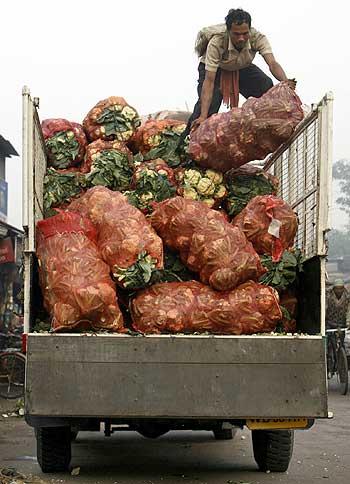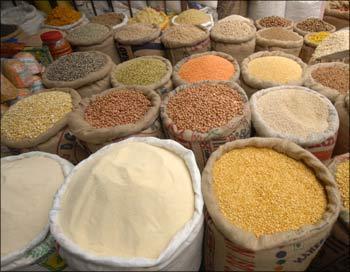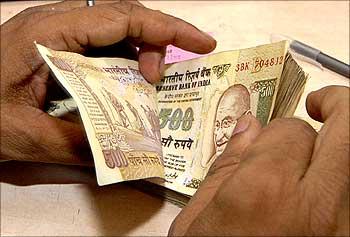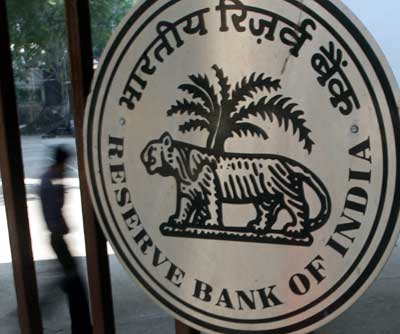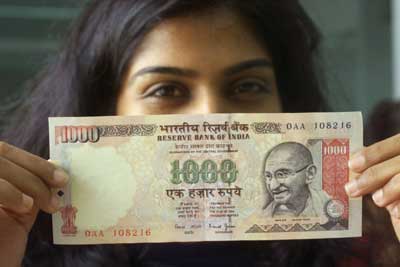 | « Back to article | Print this article |
Why India is moving to monthly inflation figures
Inflation is like a toothache. It grows slowly, inexorably, and in the end affects your efficiency. Just like for toothaches, tolerance levels vary for inflation too. Some countries can tolerate higher levels of it without growth slowing down.
For others, the threshold is lower. Developed countries have lower inflation thresholds -- as usual the rich are softer -- and developing countries have higher thresholds.
From now on, India will present inflation figures on a monthly basis instead of the existing weekly system.
Commerce Minister Anand Sharma too had recently said that the government would also change the base year to 2004 from the present 1993/94 for calculating inflation, likely from November 14.
Here, we talk about this shift in inflation data presentation and its implications. Click on NEXT to read on further. . .
Why India is moving to monthly inflation figures
Why this sudden change?
Analysts say since weekly data on wholesale price index-based inflation do not adequately capture the movement of prices of manufactured goods, government has to often revise the figures later.
"The monthly inflation data would be introduced once a new data series comes," Sharma said, adding that the government will continue with its weekly release of inflation data on food and fuel prices.
In a recent Reuters news report, A Prasanna, an analyst with ICICI Securities Primary Dealership, said, "It is definitely a welcome move that will help provide data closer to reality. Currently, manufacturing data, which carries over 60 per cent weight in the index, is not updated on a weekly basis. There will be no loss of information as the government will continue to provide data on food and fuel inflation on a weekly basis."
Currently, the government releases the wholesale price index every week and consumer price index, where food items have greater weightage, every month. However, WPI is more closely watched as it covers a higher number of products.
In recent months, the WPI and CPI have shown a wide divergence which has made policy making difficult.
Why India is moving to monthly inflation figures
What the experts say
According to the business and finance desk head of a leading English daily, the change brought in by the government 'was long overdue'.
"If we want to make ourselves economically self-reliant, we just cannot remain indifferent to what the developed countries are doing," he told rediff.com.
"Besides, WPI is not at all a scientific method of calculating inflation. It is only CPI that reflects the true picture," he added.
Kolkata-based statistician Sankar Prasad Ghosh too feels the same. "India always adopts scientific methods ages after western countries have adopted them. In case of fixing the method of calculating inflation too, there is no exception.
"Economists and analysts have been campaigning for monthly data on wholesale price index-based inflation. But government did not pay heed.
"Ultimately, when WPI and CPI started showing a wide divergence, it understood the need for a change.
"Now that we expect to get a more realistic figures of inflation, let us see what the government does to curb the ever-increasing prices", Ghosh told rediff.com.
Why India is moving to monthly inflation figures
Let's understand inflation better
An inflationary situation is where there is 'too much money chasing too few goods'.
As products/services are scarce in relation to the money available in the hands of buyers, prices of the products/services rise to adjust for the larger quantum of money chasing them.
As someone once said, "Inflation is when you pay $15 for a $10 haircut you used to get for $5 when you had hair."
Why India is moving to monthly inflation figures
Economists talked of a change in 2007
According to a Commodity Online article, economists V Shunmugam and D G Prasad working with India's largest commodity bourse -- the Multi Commodity Exchange -- came out with a research paper as early as in 2007 arguing that the government urgently needs to shift the method of calculating inflation.
Saying that there are serious flaws in the present method of calculating inflation, the paper India should adopt methodologies in developed economies.
India used to use the Wholesale Price Index to calculate and decide the inflation rate.
Most developed countries, however, use the Consumer Price Index to calculate inflation.
The WPI is published on a weekly basis and the CPI, on a monthly basis.
Why India is moving to monthly inflation figures
The logic behind this change
In the same article, Shunmugam and Prasad reasoned why it is essential that India abandoned WPI and adopted CPI to calculate inflation.
"CPI is the official barometer of inflation in many countries such as the United States, the United Kingdom, Japan, France, Canada, Singapore and China.
The governments there review the commodity basket of CPI every 4-5 years to factor in changes in consumption pattern," said their research paper.
The paper said the main problem with WPI calculation is that more than 100 out of the 435 commodities included in the Index have ceased to be important from the consumption point of view.
Shunmugam said WPI is supposed to measure impact of prices on business.
"But we use it to measure the impact on consumers. Many commodities not consumed by consumers get calculated in the index. And it does not factor in services which have assumed so much importance in the economy," he pointed out.
Why India is moving to monthly inflation figures
Government's explanation
The government recently justified the introduction of separate index numbers for primary products and manufacturing items, saying the new mechanism give better reflection of price movements.
"So this change enables everyone to know reality. . .," Industrial Policy and Promotion secretary Ajay Shankar told reporters.
He said the idea behind coming up with separate inflation numbers for primary articles -- items found in raw form -- and manufactured products is that prices of these two categories move somewhat independently at times.
"So, the results which have come out has shown that food inflation has been high whereas wholesale price index was quite low in the preceding month," the official said.
The government has for the first time come out with separate wholesale price index numbers for primary articles, fuels, and will issue another index on a monthly basis for all commodities, including manufacturing, next week.
Shankar said inflation numbers to be released on November 12 will be based on old time series, that is based on 1993-94 prices.
He said the new series will be out very soon. The new series will be based on 2004-05.
Primary articles have a weight of 22 per cent in wholesale price inflation, while fuel articles and manufacturing items account for around 14 and 66 per cent, respectively.
As a result the index numbers are skewed towards manufacturing numbers and may not reflect true picture of food price increases.
In fact, because of higher weight of food items, around 60 per cent, in various consumer price indices, retail inflation is much higher than wholesale price index numbers.
Why India is moving to monthly inflation figures
What is Wholesale Price Index?
WPI is the index used to measure the change in the average price level of goods traded in wholesale market.
WPI was first published in 1902, and was one of the more economic indicators available to policy makers until it was replaced by most developed countries by the Consumer Price Index in the 1970s.
In India, a total of 435 commodities data on price level is tracked through WPI which is an indicator of movement in prices of commodities in all trade and transactions. It is also the price index which is available on a weekly basis with the shortest possible time lag only two weeks.
The Indian government has taken WPI as an indicator of the rate of inflation in the economy.
Why India is moving to monthly inflation figures
What is Consumer Price Index?
CPI is a statistical time-series measure of a weighted average of prices of a specified set of goods and services purchased by consumers.
It is a price index that tracks the prices of a specified basket of consumer goods and services, providing a measure of inflation.
CPI is a fixed quantity price index and considered by some a cost of living index. Under
CPI, an index is scaled so that it is equal to 100 at a chosen point in time, so that all other values of the index are a percentage relative to this one.
Why India is moving to monthly inflation figures
What prevented India to switch to the CPI method earlier?
According to finance ministry officials, there were many intricate problems from shifting from WPI to CPI model.
First of all, they say, in India, there are four different types of CPI indices, and that makes switching over to the Index from WPI fairly 'risky and unwieldy.'
The four CPI series are: CPI industrial workers; CPI urban non-manual employees; CPI agricultural labourers; and CPI rural labour.
Second, officials reasoned that the CPI could not be used in India because there wa too much of a lag in reporting CPI numbers.
These 'hurdles', however, don't seem to bother the officials any more.

